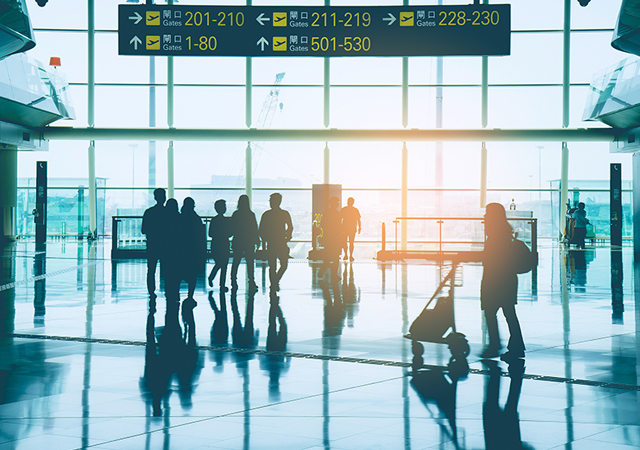
 Image by Sikov - BigStock
Image by Sikov - BigStock
The Middle East has transformed from a technical stop to a global aviation hub, with leading global airlines competing for comprehensive networks and high service levels. The industry constantly evolves, with new competitors and emerging markets.
With a GDP of $3.5 trillion, the Middle East is equivalent to the world's 17th largest country. The next decade promises to be an exciting and potentially disruptive period of change, according to a report by OAG, a leading aviation data and analytics company.
A CONSTANTLY CLIMBING MARKET
The Middle East has experienced rapid growth since 2000, ranking as the seventh largest region globally with 70 million seats per annum. The Annual Average Growth Rate (AAGR) has been 6.8 per cent, twice the global rate. The top three countries, UAE, Saudi Arabia, and Qatar, account for 61 per cent of all airline capacity in the region. The number of locally based airlines has doubled in the last two years, creating more direct employment and income for the local economy, revealed the report.
Since 2010, the number of airlines operating in the Middle East has stabilised, with around 160 non-domiciled carriers and 38 locally based ones. New destinations are added by local airlines, such as Saudia, Emirates, and Oman Air. The number of airport pairs has increased, with nearly twice as many served from the region. Competition between local and non-domiciled airlines remains competitive, especially between legacy and low-cost airlines.
STRIVING FOR PROFITABILITY
The Middle East market is experiencing constant growth, but profitability remains a challenge for smaller airlines, particularly those operating routes fulfilling social requirements. Larger network carriers like Emirates and Qatar Airways have reported exceptional profitability in 2023, with Emirates' six-month results reporting a $2.7 billion profit and Qatar Airways' $1.0 billion profit.
However, smaller airlines, such as Oman Air, have struggled with profitability, with the latter paying a record $75 million to KLM/Air France for London Heathrow slots in 2016. Saudia, the region's largest airline, is hopeful of returning to profitability by the end of this year, stated the report.
Despite a slowdown in market growth and expansion into new destinations, many carriers struggle to break even, making profitability a daily success story. A sudden market change could be disruptive, as Saudi Arabia's investment in the Vision 2030 project could have a dramatic impact on the industry.
DISRUPTIVE MARKET FORCES
The aviation industry is constantly challenged by geopolitical events, pandemics, and environmental events. The Covid-19 pandemic has led to a near four-year recovery in most markets, but now Saudi Arabia's Vision 2030 is a significant development that could disrupt the Middle East aviation market.
The Vision 2030 plan aims to transform Saudi Arabia into a major service and tourism-based economy, aiming to create an ambitious, vibrant society and make it the key commercial and cultural center in the Middle East.
The plan calls for tourism to account for over 10 per cent of GDP by 2030, generating at least one million additional jobs through GIGA projects and an additional 150,000 hotel rooms. The ambition is to reach 300 million air passengers by 2030, with 100 million being tourists, according to the report.
However, achieving this target requires international capacity growth of over 20 per cent per annum, three times higher than the average since 2010 through 2019 and pre-pandemic levels. The aviation sector faces supply challenges, but there is confidence in Saudi Arabia's ability to reach its targets under Vision 2030.
NEW AIRLINES, AIRCRAFT ORDERS & RESOURCES (EVENTUALLY)
Riyadh Air, a new airline in Saudi Arabia, aims to connect the capital city to over 100 international destinations, potentially creating around 200,000 jobs. However, ongoing production issues at Boeing and Airbus may delay the initial timescales.
Riyadh Air's contribution to the 300 million passenger target is doubtful, as they focus on Jeddah and the religious markets to the city. The revised focus places more emphasis on Saudia's profitability, including the utilisation of 39 B787s ordered in 2023.
NEOM Air, another new airline under development in Saudi Arabia, plans to launch later in 2024. However, the airline has no IATA designation, no aircraft ordered, or announcements of any network plan, making a 2024 start doubtful. The availability of qualified staff for operational operations is another challenge.
The global pilot shortage has become more severe post-pandemic, leading to higher labor costs for experienced flight crews. Recruitment fairs around the world are being held to attract qualified pilots, claimed the report.
BALANCING PRODUCT MIX AND MARKET CREATION?
The demand for luxury accommodations in Saudi Arabia is expected to reach 300 million passengers, with the demand being stimulated by low-cost airlines and high-quality accommodation options. However, this may not align with the current product positioning of luxury resorts under development.
The development of luxury accommodation may align with Vision 2030 goals, but it may not be practical to attract visitors beyond the wealthiest of travelers, as introducing six-star accommodation products is unlikely to deliver the expected outcomes, said the report.
HELP YOURSELF TO MY MARKET – NOT!
Locally based airlines have initially focused on attracting connecting traffic between different regions, with Emirates accounting for just over half of all traffic. Doha has 85 per cent of connecting traffic, while Turkish Airlines flies to more countries than any other airline globally. To develop connecting traffic via Riyadh, a competitive product offering low airfares, rapid connectivity, and attractive stop-over packages is needed, showed the report.
The ten largest airlines in the Middle East have a combined order book of 795 aircraft to be delivered by the end of 2029. Airbus estimates that around 58 per cent of new aircraft deliveries will be for network expansion. By 2029, 107 million extra seats will be added by local airlines, adding complexity to market conditions and Saudia's Vision 2030 ambitions.
BALANCING AMBITION WITH REALITY
Saudi Arabia needs to shift its economy from an oil-based one to sectors like travel, aviation, and service. The Vision 2030 aims to outperform its neighbors, but achieving the 300 million passenger target by 2030 is challenging due to a difficult aircraft supply market, expensive operational staff, and competing airlines. However, if Vision 2030 achieves half of its ambition, an additional 100 million passengers passing through Saudi airports would still be a remarkable success story, concluded the report.
